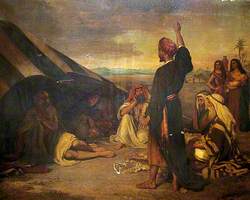How you can use this image
This image is available to be shared and re-used under the terms of the Creative Commons Attribution-NonCommercial-ShareAlike licence (CC BY-NC-SA).
This image can be reproduced in any way but your use of it cannot be for any kind of commercial purpose. Any work you create using this image must also be
Wherever you reproduce the image or an altered version of it, you must attribute the original creators (acknowledge the original artist(s), the person/organisation that took the photograph of the work) and any other stated rights holders.
Review our guidance pages which explain how you can reuse images, how to credit an image and how to find more images in the public domain or with a Creative Commons licence available.
DownloadNotes
Add or edit a note on this artwork that only you can see. You can find notes again by going to the ‘Notes’ section of your account.
Born in Mosul, Rassam began a distinguished archaeological career as assistant to A. H. Layard during his excavations at Nimrud and Kuyunjik from 1845 to 1847. He again accompanied Layard to Assyria and Babylonia from 1849 to 1852 and when Layard moved into politics continued under the nominal supervision of Henry Rawlinson. His discoveries included Ashurbanipal’s north palace with its lion-hunt sculptures and cuneiform texts. There followed an interlude as Arabic interpreter which included his detention with other hostages by Emperor Theodore of Abyssinia and his rescue by the British Army. He excavated again, particularly in Babylonia, 1878–1882, discovering the Balawat gates, a cylinder fragment recording Cyrus’s capture of Babylon, and a vast cache of inscribed tablets and fragments at Sippar.
Title
Hormuzd Rassam (1826–1910)
Date
1869
Medium
oil on canvas
Measurements
H 110 x W 83.5 cm
Accession number
1955,0630.1
Acquisition method
gift from the Brighton & Hove Museum, 1955, to whom it had been given by the artist's daughter
Work type
Painting







